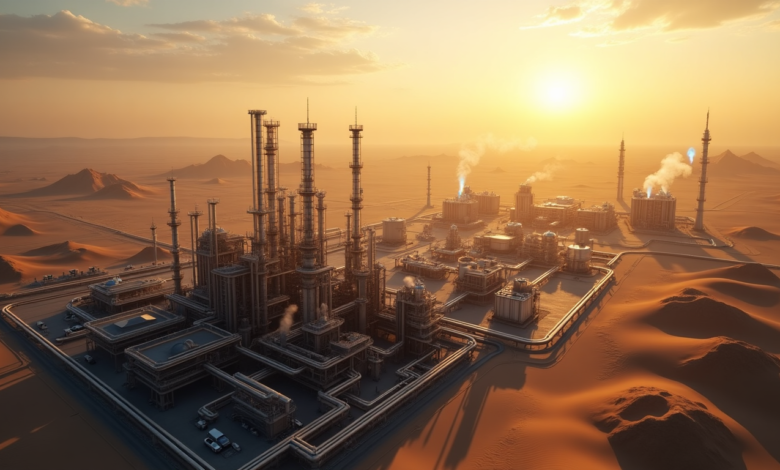
2025 MENA Oil & Gas Report: Investment Opportunities and Challenges
The oil & gas industry in the Middle East and North Africa (MENA) region continues to play a pivotal role in global energy markets. As major producers like Saudi Arabia, the UAE, and Qatar shape the landscape, the sector faces both challenges and opportunities. From fluctuating oil prices to the growing emphasis on natural gas and renewable energy, the MENA oil & gas scene is evolving rapidly.
This report examines key trends and projections for the MENA oil & gas market through 2025. It analyzes oil production forecasts, explores the natural gas outlook, and evaluates the investment climate. The study also looks at how factors like the energy transition, sustainable financing, and hydrogen projects are changing the industry. By providing insights on these crucial areas, this report aims to guide stakeholders in navigating the dynamic MENA oil & gas sector.
MENA Oil & Gas Market Overview
The Middle East and North Africa (MENA) region continues to play a pivotal role in the global oil & gas landscape. With approximately 57% of the world’s proven oil reserves and 41% of natural gas resources, the region remains a cornerstone of the global energy ecosystem. The geological framework of MENA favors the generation and accumulation of vast hydrocarbon reserves, making it home to some of the world’s largest conventional onshore and offshore fields.
Current state of the MENA oil & gas sector
The energy and resources sector serves as the foundation for economic growth and development in MENA countries. Currently, the region accounts for about 31% of global oil production, with crude oil output standing at approximately 30.4 million barrels per day. Natural gas production in MENA has reached 925 billion cubic meters, constituting roughly 23% of total global gas production.
Major oil producers within the region include Saudi Arabia, Iraq, UAE, Kuwait, and Iran, while gas production is dominated by Iran, Qatar, Saudi Arabia, Algeria, Egypt, and the UAE. The sector remains strictly regulated, with national oil companies (NOCs) responsible for developing oil & gas resources in their respective countries.
Key players and market dynamics
NOCs play a crucial role in shaping the MENA oil & gas landscape. Prominent NOCs include Saudi Aramco, National Iranian Oil Company, Kuwait Petroleum Corporation, and Abu Dhabi National Oil Company (ADNOC). These companies often form strategic partnerships with international oil companies (IOCs) such as BP, Chevron, Shell, and ExxonMobil to leverage technological expertise and financial capabilities.
The oil field service (OFS) sector also plays a vital role in the value chain, with companies like Schlumberger, Baker Hughes, and Halliburton providing essential products and services for exploration, development, and production activities.
Impact of global economic trends on MENA oil & gas
The MENA oil & gas sector has experienced significant challenges and changes in recent years. The global energy transition has prompted regional NOCs to diversify investments into new technologies and fuels, conserve hydrocarbon reserves, and reduce greenhouse gas emissions through clean tech and reduced consumption.
The ongoing Russia-Ukraine conflict has deeply impacted the European energy supply market, leading to a shift in focus towards energy security and diversification of natural gas supplies. This situation has created new opportunities for MENA producers to expand their market share in Europe.
Despite the push towards renewable energy, MENA oil & gas producers recognize that hydrocarbons will remain the world’s primary energy source for decades to come. As a result, they are investing heavily in expanding upstream and downstream production capacity. The region’s five-year (2022-2026) energy investment portfolio comprises a total investment of USD 879 billion, representing a 9% increase over the previous projection.
Oil Production Projections
Country-wise oil production forecasts
The Middle East and North Africa (MENA) region continues to play a pivotal role in global oil production. As of 2024, the region accounts for approximately 31% of global oil output, with crude oil production standing at around 30.4 million barrels per day. Looking ahead to 2025, projections suggest a slight increase in production levels, albeit with some variations across countries.
Saudi Arabia, the region’s largest producer, is expected to maintain its dominant position. The kingdom’s oil production is forecasted to remain stable, with potential for modest growth as it balances market share considerations with price stability. The United Arab Emirates (UAE) is poised for growth, with plans to expand its production capacity. Iraq, despite facing some challenges, is projected to increase its output, potentially exceeding its current quota of 4 million barrels per day.
Iran’s production outlook remains uncertain due to geopolitical factors, while Kuwait and Qatar are expected to maintain steady production levels. Egypt, although a smaller producer, is likely to see a slight increase in output as it develops new oil fields.
OPEC+ influence on regional production
The OPEC+ alliance, which includes OPEC members and non-OPEC producers like Russia, continues to have a significant impact on oil production in the MENA region. The group’s decisions on output levels and production cuts have a direct influence on the region’s oil production projections.
OPEC+ has implemented a series of output cuts since late 2022 to support oil prices, with most of these cuts set to remain in place until the end of 2025. The alliance’s ability to manage supply and demand has had a considerable effect on market stability and price levels.
However, the effectiveness of production restraints may be challenged in 2025 as demand growth slows and non-OPEC+ supply continues to expand. This could lead to potential disagreements within the alliance about the best approach to maintain market share while supporting prices.
Technological advancements in oil extraction
The MENA region is witnessing a shift towards unconventional and tight-gas resource development, driven by the need to meet growing energy demands and maintain market share. This transition has necessitated the adoption of advanced technologies and equipment to access challenging reservoir environments.
Enhanced Oil Recovery (EOR) techniques are gaining prominence, helping to increase proven reserves and keep older oil fields productive. These technologies are crucial for maintaining and potentially increasing production levels in mature fields across the region.
Digitalization and data analytics are also playing an increasingly important role in optimizing oil extraction processes. The implementation of intelligent oilfield technologies, including comprehensive sensing, integration, and early warning systems, is enhancing production efficiency and reducing equipment maintenance costs.
As the industry evolves, there is a growing focus on developing tailored solutions for the specific challenges faced in the MENA region. This includes the creation of new methodologies and technologies designed to optimize the development of unconventional and tight-gas reservoirs, which are becoming more prevalent in countries like Saudi Arabia and the UAE.
Natural Gas Outlook
The natural gas sector in the Middle East and North Africa (MENA) region is poised for significant growth and transformation. With approximately 41% of the world’s natural gas resources, the region plays a crucial role in the global energy landscape. As of 2022, the total volume of liquefied natural gas (LNG) traded worldwide reached 542 billion cubic meters, with MENA countries contributing substantially to this figure.
LNG export potential in the region
Qatar stands out as the world’s leading exporter of LNG, with its exports making up nearly 70% of the MENA region’s total LNG exports. The country has ambitious plans to expand its LNG export capacity from the current 77 million tons per annum (mtpa) to 142 mtpa by the end of 2030. This expansion is set to solidify Qatar’s position as a dominant player in the global LNG market.
Other Gulf Cooperation Council (GCC) countries are also ramping up their LNG export capabilities. The United Arab Emirates (UAE) is developing a new LNG export complex in Ruwais, which is expected to more than double its LNG export capacity to just above 15 mtpa. Oman, too, has announced plans to expand its LNG export capacity by a third, leveraging recent upstream gas developments.
Domestic gas consumption trends
Despite being major exporters, many MENA countries are experiencing rapid growth in domestic gas consumption. Since 2010, the demand for gas in the region has grown at a compounded annual rate of about 5 percent. This surge in demand is driven by population growth, industrial expansion, and the increasing use of natural gas for power generation.
The natural gas power generation capacity in the Middle East is projected to grow from around 965.4 terawatt hours to over 1,667 terawatt hours by 2035. This significant increase highlights the region’s growing reliance on natural gas for its energy needs.
Unconventional gas developments
To meet the rising domestic demand and maintain export capabilities, MENA countries are increasingly turning to unconventional gas resources. Saudi Arabia, the UAE, Oman, and Algeria are at the forefront of these developments, with ambitious plans for shale and tight gas projects.
Saudi Arabia, in particular, has begun exploring its large unconventional deposits, with Saudi Aramco currently appraising several prospects, including the northwest region, the south Ghawar field, and the Jafurah and Rub’al-Khali basins. Baker Hughes estimates Saudi Arabia’s shale gas reserves at 645 trillion cubic feet (Tcf), indicating significant potential for long-term growth.
Algeria is also making strides in unconventional gas development, with drilling and hydraulic fracturing activities underway in western basins such as Ahnet and Tinhert. The country hopes to begin commercial production of unconventional gas within the next five years.
These unconventional gas developments face challenges, including high-pressure and high-temperature operations due to the depth of the resources and substantial water requirements. However, they represent a crucial step in diversifying the region’s gas supply and reducing dependence on conventional resources.
Investment Landscape
The Middle East and North Africa (MENA) region continues to play a pivotal role in the global oil & gas industry, attracting significant investments across the value chain. The investment landscape in MENA’s energy sector has experienced notable shifts in recent years, driven by various factors including economic diversification efforts, geopolitical dynamics, and the global energy transition.
Upstream, midstream, and downstream investment trends
Investments in the MENA oil & gas sector are projected to grow substantially, with a bullish outlook for capital expenditure in 2024 and 2025. This growth is fueled by a strong pipeline of projects under development in the Gulf Cooperation Council (GCC) countries. The region’s five-year energy investment portfolio (2022-2026) comprises a total investment of USD 879 billion, representing a 9% increase over the previous projection.
Upstream activities continue to dominate investment trends, particularly among emerging majors in the region. For these companies, as much as 90% of total investment is directed towards exploration and production. This focus on upstream activities stems from the realization that the energy transition is unfolding more slowly than expected, implying that oil & gas demand may remain strong for a longer period.
In the midstream sector, investments in natural gas infrastructure are forecast to grow by 5%, driven by Qatar’s LNG expansion projects, UAE’s sour gas developments, and Iraq’s gas-to-power projects. The petrochemicals sector has shown the highest increase in investments, with a 45% year-on-year growth, as several projects that were put on hold during the pandemic are now being revived.
Foreign direct investment in MENA oil & gas
Foreign direct investment (FDI) plays a crucial role in the MENA oil & gas sector, with greenfield investments being the preferred mode of entry for multinational enterprises. These investments have contributed significantly to job creation and economic growth in the region. However, FDI flows have faced challenges in recent years due to global economic uncertainties and regional instability.
The United States, France, the United Kingdom, Italy, China, Japan, India, Germany, and Austria are among the primary sources of FDI in the MENA oil & gas sector. Interestingly, cultural ties have emerged as a significant factor in attracting FDI to the region, with shared religion and language fostering investments more than in any other region globally.
Impact of energy transition on investment decisions
The global energy transition has had a profound impact on investment decisions in the MENA oil & gas sector. While the region remains committed to hydrocarbon production, there is a growing focus on sustainability and low-carbon technologies. Several MENA countries have pledged net-zero targets, with the UAE aiming for 2050 and Saudi Arabia and Bahrain for 2060.
To support these goals, investments in renewable energy and hydrogen projects are gaining momentum. The MENA region has registered more than USD 26 billion in hydrogen projects, mostly in the planning phase. By leveraging its strong potential, the region is well-positioned to supply around 10% to 20% of the global hydrogen market by 2050.
The MENA oil & gas sector is poised for significant growth and transformation in the coming years. With substantial investments across the value chain and a focus on both conventional and unconventional resources, the region is set to maintain its crucial role in global energy markets. The push towards natural gas, particularly LNG, and the development of unconventional gas resources highlight the industry’s adaptability in meeting changing energy demands.
As the sector evolves, it faces the dual challenge of meeting growing energy needs while addressing environmental concerns. The increasing focus on sustainability, renewable energy, and low-carbon technologies shows the industry’s commitment to adapt to the global energy transition. This balancing act between traditional hydrocarbon production and new energy solutions will shape the future of the MENA oil & gas landscape, ensuring its continued relevance in the global energy mix.
FAQs
What are the projected oil and gas prices for 2025?
The Energy Information Administration (EIA) has adjusted its forecast for Brent oil in 2025, reducing it by AED 23.87 to AED 284.92 per barrel. Similarly, the forecast for WTI crude has been lowered by AED 23.87 from the previous estimate, setting it at AED 268.54 per barrel.
What is the expected global trend for oil and gas inventories and prices?
Global oil inventories are anticipated to decline by 0.9 million barrels per day in the third quarter of 2024 and further decrease by over 1.0 million barrels per day through the first quarter of 2025. Consequently, Brent oil prices are expected to rise from AED 271.74 per barrel at the start of September to an average of AED 301.11 per barrel in December, reaching AED 304.79 per barrel in the first quarter of 2025.
How is the oil and gas production expected to grow in 2025?
Global production of petroleum and other liquid fuels is forecasted to increase by 2.0 million barrels per day in 2025, which is a significant rise from the growth of just 0.5 million barrels per day observed this year.
What are the projections for the oil and gas industry by 2030?
By 2030, the total supply capacity of oil is expected to reach nearly 114 million barrels per day, which exceeds the projected global demand by approximately 8 million barrels per day.







[…] economic policy framework has shown remarkable results that indicates price stability](https://baytmagazine.com/index.php/2025-mena-oil-gas-report-investment-opportunities-and-challenges/) despite global challenges. The Kingdom’s proactive measures and policies have helped […]
[…] Natural gas exports […]
[…] ranks as the second-largest investor in Kurdistan and accounts for 25% of foreign direct investment. Five UAE companies have invested over AED 9.18 billion in the region […]